Four-wheel drives, such as 4×4, 4WD, AWD, can be permanent, manually engaged, or automatically engaged, among others. You just wanted to enjoy four-wheel driving, but now you might find yourself confused about what these terms mean, both in theory and practice. Some systems work well off-road, but some… even better. Let’s clear up the confusion. Find out what full-wheel drive actually is, how it works, what its types are, and which ones perform best off-road.
A bit about drivetrains in general
The driving system’s job is to transfer the engine’s power to the vehicle’s wheels, specifically to deliver torque to a certain axle. In a 4×4 drive system, both front and rear axles receive power, which significantly affects the car’s behavior during driving and its traction, especially when taking corners or starting to move. The more power is given to either the front or rear wheels alone, the higher the risk of losing grip.”
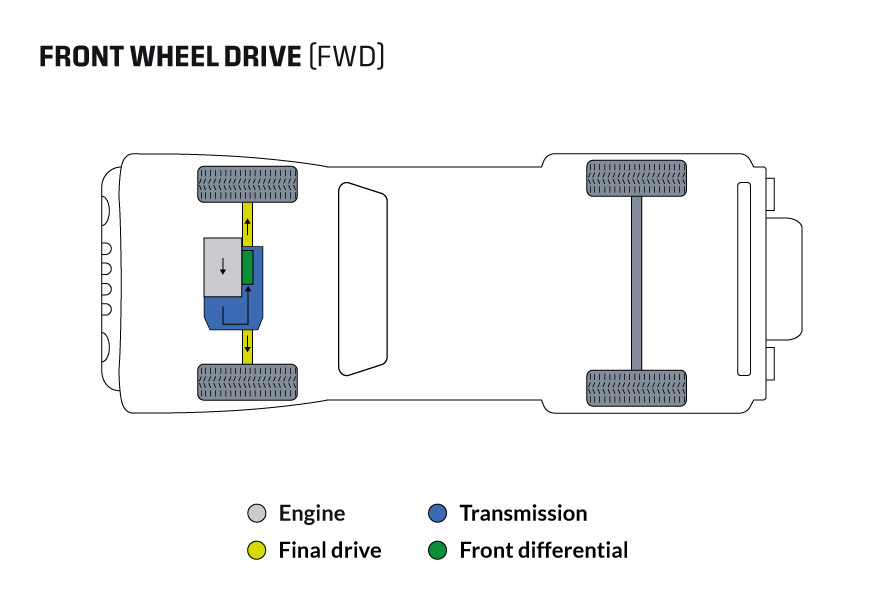
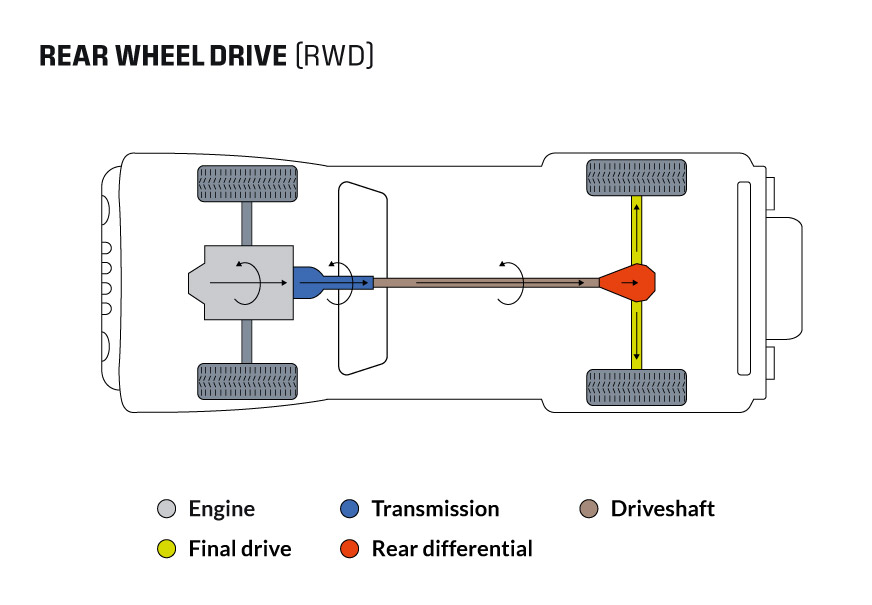
Today, the most common solution in mainstream cars is front-wheel drive (FWD), ensuring high safety and lower fuel consumption but with a greater tendency to understeer. Rear-wheel drive (RWD) is less common but still appreciated. It is used by brands like BMW and Mercedes. Drivers value the even weight distribution and the separation of steering and driven wheels, despite a clear tendency to oversteer. Drift enthusiasts know what this means.
What is a manually engaged 4×4 drive – 4WD?
Off-road enthusiasts look for something entirely different. They’re not about where to drive off-road. They are all about how to escape muddy terrain or climb the hills on unstable ground. The best solution for this is a combination of front and rear drives, resulting in four-wheel drive. However, there are about as many types of 4×4 drives as there are four-wheel drive vehicles. We will try to present the structure and operation of the basic types.
In its most traditional form, four-wheel drive means driving on one axle (usually the rear) with the option to manually engage the second axle. In classic off-road vehicles, this often meant physically getting out of the car to manually lock the hubs on the wheels. For example, an old Nissan Patrol had hubs for automatic axle engagement. In newer vehicles, control is fully from the driver’s cabin and is much more technologically advanced.
How 4WD drive works
A 4WD drivetrain consists of two driveshafts and a transfer case between them, which distributes power in ratios such as 50:50, 40:60, 30:70, etc., to both axles.
However, keep in mind that connecting both axles is “rigid”. It means that due to the lack of a central differential, they rotate at the same speed. Driving like this under standard conditions is actually cumbersome and dangerous. Especially while turning due to high stress. That’s why it’s important to disengage the 4×4 drive after off-roading.
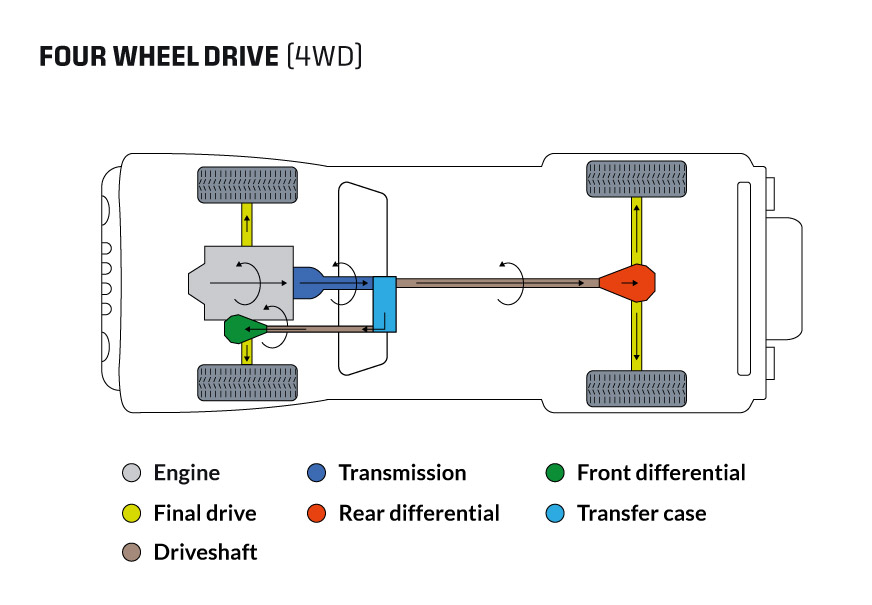
A significant advantage of this system is the additional presence of a gear reducer in the transfer case. It increases the number of gear ratios in the gearbox. This means the car gets more power at the expense of speed at low gear. In other words, it provides additional gears, making it easier to escape muddy terrain and preventing clutch burnout.
Pros and cons of 4WD drive
Pros
- Simplest design,
- High durability,
- Low failure rate (if used correctly),
- Performs very well in most off-road situations,
- The driver decides when to engage different modes.
Cons
- Engaged mode is not suitable for asphalt roads,
- Lower traction than AWD,
- Can be cumbersome to engage in older models,
- Requires knowledge of the drive and system.
for Jeep Wrangler JL and Gladiator
for Jeep Wrangler TJ
Examples of 4WD Vehicles:
Classic off-road vehicles like Suzuki Jimny, Jeep Wrangler, RAM 1500, Ford F150, Mitsubishi Pajero, Mitsubishi L200.
Related articles
Permanent 4×4 drive – benefits and differences
Manually engaged drives often posed a challenge for many drivers. They have to be physically engaged and require some off-road driving knowledge to figure out when to use them. As an alternative, permanent four-wheel drive was developed.
Permanent 4×4 distributes torque evenly or proportionally across both axles using a central differential or Torsen mechanism. As a result, more power reaches the ground, improving traction in difficult conditions, enabling smoother acceleration. And providing a better grip on the surface. That’s how things look in standard driving.
Permanent 4×4 drive in off-roading
It’s a whole different story in off-road conditions. The presence of differential mechanisms, including those on the front and rear axles, can negatively affect the all-wheel drive’s functions.
Differential mechanisms are essential components of the drivetrain. Without them, the driving wheels would spin at the same speed, leading to loss of traction. During a turn, the wheels on the outside must cover a greater distance, so they need to turn faster. Otherwise, taking a curve would be practically impossible. However, for the same reason, when stuck in a rut or on a slippery surface, where some wheels lose traction or slip, all the driving force is transferred to them. As a result, without additional support, the car cannot move.
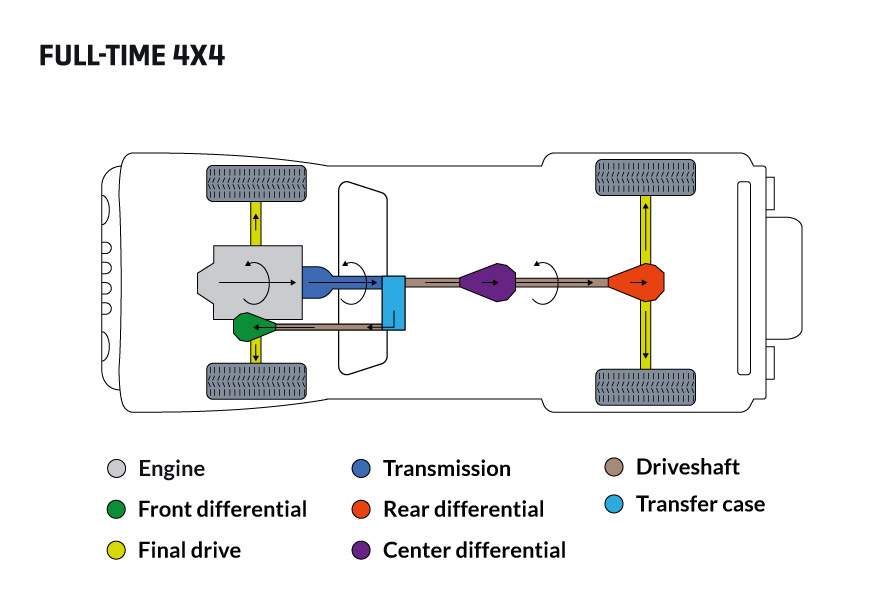
That’s why special differential locks are essential in such drivetrains. Only after preventing the wheels from moving at different speeds do we gain a real 4×4 drive distributed to all wheels, in all conditions. Therefore, this solution is more popular in racing cars such as Audi, etc.
Pros and cons of 4×4 drive
Pros
- Predictable vehicle behavior,
- High driving performance,
- Less complicated operation.
Cons
- High operating costs,
- Larger weight,
- Increased fuel consumption.
Vehicles with Permanent 4×4 drive:
Land Lover Discover/Defender, Range Rover, Toyota Land Cruiser
AWD all-wheel drive – a modern 4×4 drive
The most modern and technologically advanced all-wheel-drive systems are those with automatically engaged second axles. They are controlled electronically, hydraulically, or mechanically, but managed by a computer and entirely without driver involvement. The transfer of power between the axles is also handled by a central differential mechanism, namely a multi-plate clutch, which is divided into: the simplest viscous coupling (viscosity), the previously mentioned Torsen, and Haldex.
Such systems, based on monitoring the speed difference between the axles, determine the distribution of power between the front and rear wheels. Importantly, this distribution does not necessarily have to be proportional and constant. Instead, it is achieved through locking the differential mechanism at appropriate moments or by braking individual wheels, for example, when there is skidding or loss of traction on a particular axle. How does it work?
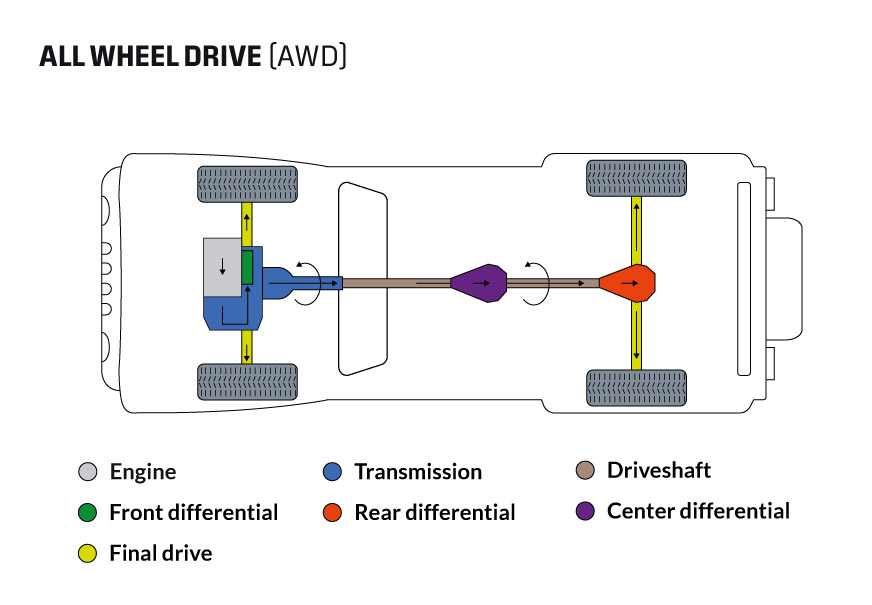
Viscosity, Torsen, Haldex – types of differentials
The viscous clutch cover is filled with oil, which thickens with an increase in temperature, for example, due to the slip of driven axle. In such a situation, the wheels on the front and rear axle move at different speeds, activating the clutch and thus engaging the 4×4 drive. Unfortunately, the simplicity of this design results in delays in transferring energy.
The Torsen (Torque Sensing) differential operates by utilizing a system of worm gears that can mechanically detect differences in the speed of rotation between the individual shafts, or variations in traction between the two axles. When one axle experiences a loss of traction, the Torsen differential transfers more torque to the axle with greater traction, allowing for smoother acceleration. It is installed both between the wheels on each axle and between the two axles, which enhances its effectiveness.
Meanwhile, the Haldex differential operates using a hydraulic coupling system and integrated with safety systems like ABS, ESP, etc. System engages and disengages the rear axle as needed based on traction conditions. When the front wheels lose traction, the hydraulic pump sends pressure to the clutch, which engages the rear axle, transferring torque to the rear wheels. This helps improve traction and stability in slippery conditions. This solution is used in the latest SUVs or crossovers.
Pros and cons of AWD drive
Pros
- Ability to drive on asphalt without switching modes,
- Assists driving in all conditions,
- More intuitive for inexperienced drivers,
- Automatic, simple operation,
- High driving economy.
Cons
- Advanced construction may be associated with higher failure rates,
- Lower off-road capabilities,
- Lack of manual control.
Examples of cars with AWD:
Toyota RAV4, Subaru Crosstrek, Subaru Forester
Which 4×4 drive is the best, or what to choose
Most likely, every off-roading enthusiast will say that the best option is a 4×4 drive with manual settings for different modes of operation and a gear reducer at disposal. It’s hard to disagree because this gives you full control over the vehicle’s behavior in really tough conditions.
That’s why, in the off-road community, the modern 4WD solution applied in the latest versions of the Jeep Wrangler, for example, a certain hybrid of manually engaged and automatic drive, is often ranked at the top. In this case, in standard driving mode, we deal with driving to one axle with the option of engaging the second one. Additionally, there is also a mode for automatic 4×4 drive or its permanent lock.
If, however, you are looking for a purely expeditionary and comfortable car for predominantly highway driving, then crossovers or SUVs might be the better choice. Automatic 4×4 drive works well when you occasionally go off into light terrain to set up camping.

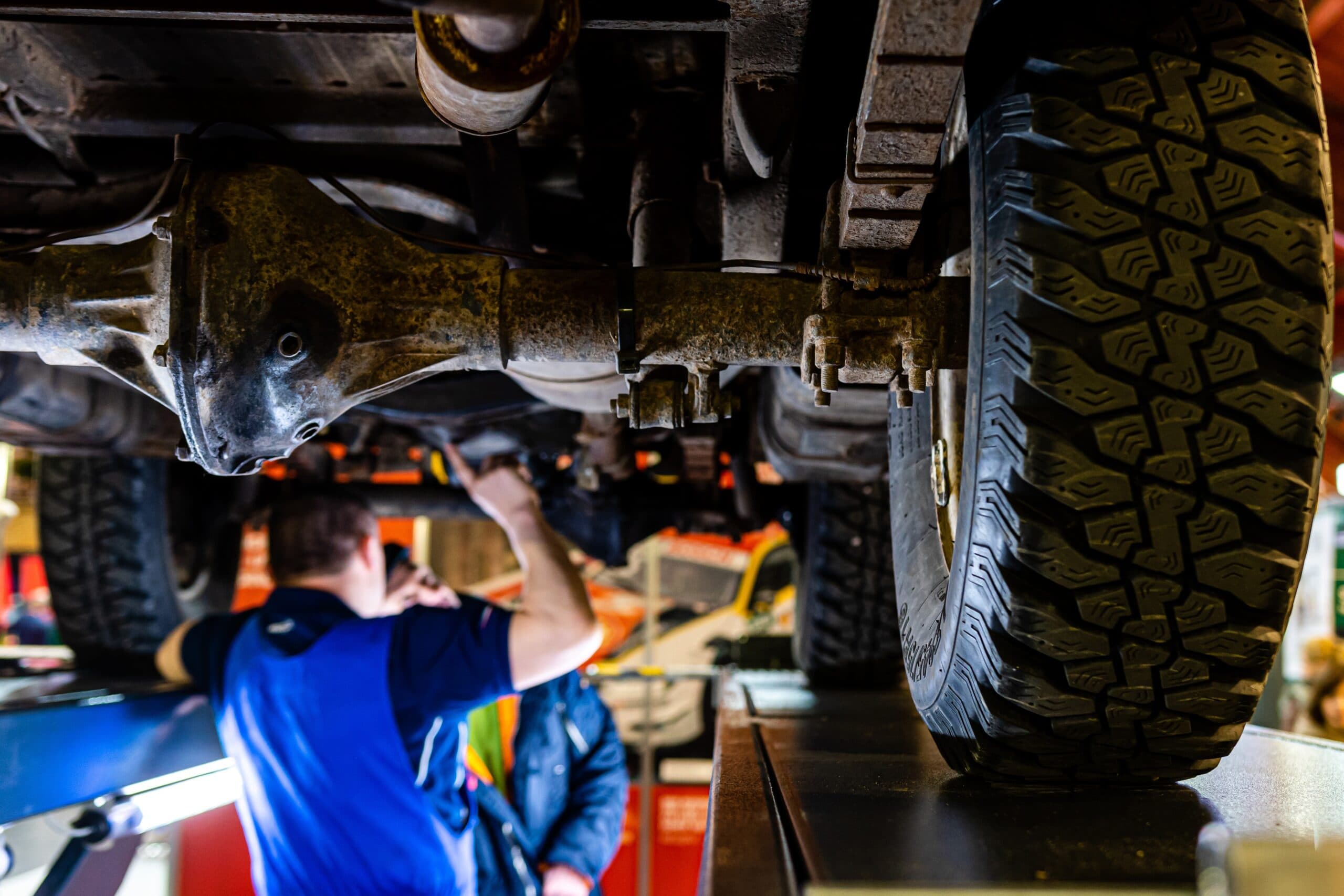




Comments ()